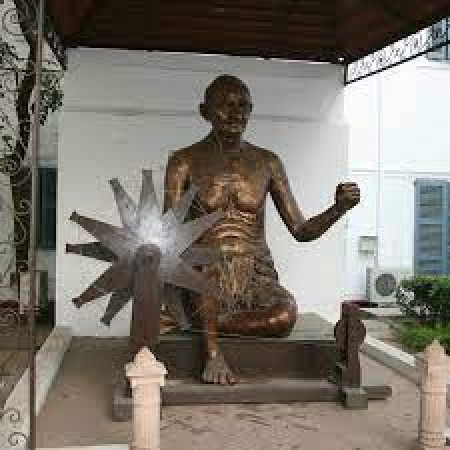Gandhi Smriti Travel Guide
Gandhi Smriti, located in New Delhi, India, is a significant historical destination that served as Mahatma Gandhi's residence in his final days. This sacred place is a museum dedicated to the life and teachings of the Father of the Nation, showcasing his personal belongings, photographs, and artifacts. Gandhi Smriti holds immense cultural importance as it marks the spot where Gandhi was assassinated on January 30, 1948. Visitors can explore the serene gardens and the Martyr's Column, which stands as a tribute to his non-violent principles.Top Attractions in Gandhi Smriti
- Martyr's Column
- Gandhi's Room
- Photo Exhibition Gallery
- Library and Research Center
Gandhi Smriti is Famous for
Being the final residence of Mahatma Gandhi and the site of his assassination.Top Attractions in Gandhi Smriti
- Experience Gandhi's last footsteps
- Attend the daily prayer service
- Reflect at the Martyr's Column
- Explore the exhibitions and artifacts
What's Great about Travelling to Gandhi Smriti?
- Immerse in the life and teachings of Mahatma Gandhi
- Gain insight into India's freedom struggle
- Experience a sense of peace and reflection
What's Not So Great about Travelling to Gandhi Smriti?
- May not appeal to those uninterested in history or culture
- Limited dining options in the vicinity
- Can get crowded during peak tourist seasons
Travel Tips for Gandhi Smriti
- Respect the sanctity of the place and maintain silence
- Wear comfortable footwear for walking around the museum
- Carry a valid ID proof for entry
Important Gandhi Smriti trip information
- Ideal Duration: A visit typically takes 1-2 hours.
- Best Time to Visit: October to March for pleasant weather.
- Nearby Airports and Railway Stations: Indira Gandhi International Airport and New Delhi Railway Station.
FAQ's on Gandhi Smriti
Q1: What is the best time to visit Gandhi Smriti?
The best time to visit Gandhi Smriti is during the winter months from November to February when the weather is pleasant and ideal for exploring outdoor attractions. This period also coincides with various events and festivals in the region, offering a vibrant cultural experience for visitors. It is advisable to avoid the summer months due to high temperatures and humidity.
Q2: Do I need a visa to travel to Gandhi Smriti?
Travelers to Gandhi Smriti typically require a valid tourist visa to enter the country. However, some nationalities may be eligible for visa-on-arrival or e-visa facilities. It is essential to check with the local embassy or consulate for specific visa requirements, including any exceptions or special considerations based on your nationality.
Q3: What are the must-visit attractions in Gandhi Smriti?
Gandhi Smriti offers a rich cultural and historical experience with must-visit attractions such as the Gandhi Smriti Museum, Raj Ghat, and National Gandhi Museum. Visitors can explore the serene surroundings where Mahatma Gandhi spent his last days and gain insights into his life and teachings. Other popular sites include the Akshardham Temple, Lotus Temple, and India Gate, offering a blend of spirituality and history.
Q4: Is Gandhi Smriti a safe place to travel?
Gandhi Smriti is generally considered safe for travelers, but like any destination, it is advisable to exercise caution and be aware of your surroundings. It is recommended to avoid isolated areas, especially at night, and take necessary precautions to safeguard your belongings. Travelers are encouraged to stay informed about local developments and follow any travel advisories issued by their respective governments.
Q5: What is the local currency in Gandhi Smriti and can I use credit cards?
The local currency in Gandhi Smriti is the Indian Rupee (INR). ATMs are widely available in major cities and tourist areas, allowing visitors to withdraw cash conveniently. Credit cards are accepted at most hotels, restaurants, and shops in urban areas, but it is advisable to carry some cash for smaller establishments and markets.
Q6: What is the local cuisine like in Gandhi Smriti?
The local cuisine in Gandhi Smriti offers a diverse range of flavors and dishes, reflecting the country's rich culinary heritage. Visitors can savor traditional Indian delicacies such as biryani, samosas, tandoori dishes, and various regional specialties. Vegetarian options are widely available, catering to different dietary preferences. Travelers can also enjoy street food experiences, authentic thalis, and popular sweets like gulab jamun and jalebi.
Q7: What transportation options are available in Gandhi Smriti?
Gandhi Smriti offers various transportation options for travelers, including public transport like buses, metros, and trains for convenient city travel. Taxis and auto-rickshaws are readily available for short distances, while app-based ride-hailing services are popular in urban areas. Rental cars and bikes are also options for exploring the region at your own pace. It is advisable to negotiate fares beforehand and choose reliable transportation providers.
Q8: Are there any cultural norms or etiquette I should be aware of when visiting Gandhi Smriti?
When visiting Gandhi Smriti, it is essential to respect local customs and traditions. Dress modestly, especially when visiting religious sites, and remove your shoes before entering temples or homes. Greeting people with a traditional "Namaste" and showing respect to elders are considered polite gestures. Avoid public displays of affection, especially in rural areas, and ask for permission before taking photographs of individuals. It is advisable to learn about the cultural norms and practices of the region to ensure a respectful and enjoyable travel experience.
Q9: I am a travel agent. How can I buy travel leads of Gandhi Smriti?
Register yourself as a travel agent at agents.tripclap.com and then you can buy travel leads to Gandhi Smriti once your account is approved. For more details contact our support team at +91-8069186564 or support@tripclap.com

